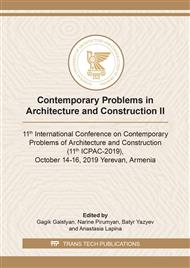p.24
p.31
p.40
p.53
p.58
p.63
p.68
p.73
p.81
Stone and Brick Work Churches Composition and Structural Features
Abstract:
One of the typical features of the early Armenian culture of cemetery is its original church architecture. The radical changes in socio-economic and political relations were the basis of 301 cc to proclaim Christianity as a state religion. Church building has a great progress in the high middle Ages (9th-14th cc.) Where stone blocks are used as a building blend together with bricks. In the article, comparisons have been made between the Kirants Monastery and Makaravank, which are located in the same region and were built at the same time. As a result of the study, it is noticeable that these two monasteries, which have been high middle age construction material, have eras and similar buildings (churches, subsidiary structures, cemeteries around). Churches are a cross-shaped central dome and a domed hall volumetric spatial type. The facade is decorated with luxurious decoration, the exterior facades are decorated with colored bricks in Kirants monastery, and in Makaravank, in the form of stone carving. Similarities are seen in structured nodes - entrances and windows. There are remarkable differences in interior decorations - the interior walls of the Kirants monastery are decorated, with a small part of them preserved up to now, and there is no interior decoration in Makaravank.
Info:
Periodical:
Pages:
58-62
Citation:
Online since:
December 2019
Authors:
Keywords:
Price:
Сopyright:
© 2020 Trans Tech Publications Ltd. All Rights Reserved
Share:
Citation:


